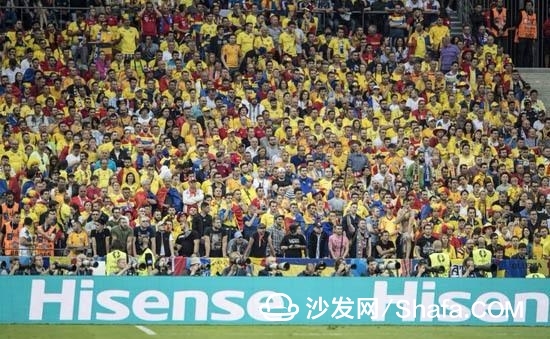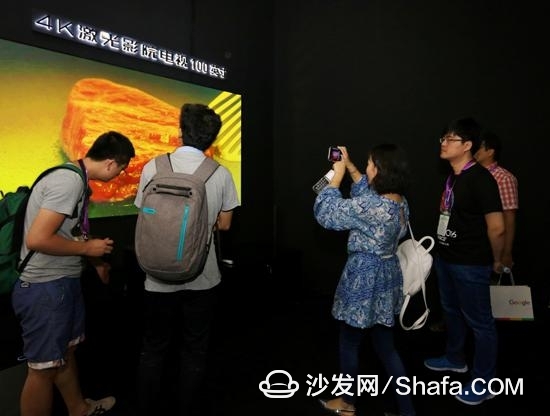It is worth mentioning that, behind the overseas warfare, technology warfare, brand warfare, and cross-border warfare that the color TV industry has detonated this year, the dominant players are no longer foreign companies such as Korea and Japan in the past, but are local military groups led by Hisense. Especially in the display technology war involving industrial development initiative and the hardware and content cross-border integration warfare involving the next industrial outlet, local legions have established differentiated dominant advantages.
First battle: Display technology catches up
Confronted with China's lack of color TV display technology for a long time, Chinese companies headed by Hisense continued to counterattack in recent years. This year, they relied on the newly upgraded 8K ultra-resolution ULED and 4K laser display technology to re-create their own original display technology. Upstairs.
The monitoring data from Ovid Cloud Network shows that: In the first half of this year, the sales volume of the domestic color TV market increased by 6.9% year-on-year to 23.51 million units; the sales volume decreased by 4% year-on-year to 71 billion yuan. Behind the backdrop of increasing volume and lower prices, there is a lack of display technology originality that has plagued Chinese companies for a long time.
In the face of this situation, Hisense, which has always been driven by technological innovation, started a pioneering and pioneering display technology battle many years ago. It has successively completed breakthroughs in TV image chips and ULED display technology and established China. Display a place in the world. In this year, we have successively promoted the dual iterations of ULED display technology and laser display technology to achieve a leap from leading to leading.

It can be seen that this year, Hisense has successively launched a series of new products such as UHD, 8K ULED, and 4K laser cinema. This will not only continue to consolidate the position of Hisense and other Chinese companies in global display technology, but also use ULED and laser display for two rounds. Layout to realize overtaking at corners of global display technology.
Second Battle: The Rise of Overseas Markets
This year, China's color TV companies also ushered in a new turning point in globalization and business operations. From the past, they exported products to the world in a “Made in China†fashion and quickly upgraded to lead global consumption with the commercial wisdom of Chinese products, brands and operations.
Hisense has once again become China's flag-bearer for overseas TV battles, inspiring overseas competition through a series of original products. In contrast to the overseas expansion of some companies many years ago focused on the export of low-end products, this overseas market led by Hisense has fully focused on China's original fine products and new products, targeting high-end and high-quality consumer groups, and creating new strengths of “Made in Chinaâ€.
After completing the acquisition and integration of Sharp's Americas business last year, in March this year, Hisense "worldview" series ULED ultra-vision TV MU7000 was unveiled for the first time, and was simultaneously listed and sold in 67 countries around the world. This is the first color TV company in China to take the lead in China. The original display technology products were introduced to the global market, which opened the curtain for the front-line offensive of Chinese color TVs in the global market.
On the eve of the European Cup final, Hisense launched the first 4K ultra-short-focus laser cinema TV in France. This is the second time that ULED TV has once again competed with the Chinese original laser technology. Hisense has not only dominated the Chinese color TV market for 13 consecutive years, but has also achieved the leading position in the global market. The monitoring data from the third-party market research agency HIS showed that it was ranked among the top three in the world in 2015, and in the first quarter of 2016, Hisense once again ranked among the top three in the world.
Insiders pointed out that with the rapid decline of Japanese companies in the global market, Chinese companies headed by Hisense successfully seized the opportunity to completely rewrite the past pattern of “South Korea, China, and China†three countries into hegemony of “China and South Koreaâ€.
The third battle: Chinese brands usher in the peak
For a long time, the impression China's home appliance companies have given to the rest of the world is that they are producing "good and cheap" products. As China’s color TVs took the lead in achieving breakthroughs in core display technologies, and global manufacturing and operating teams brought about by capital mergers and acquisitions quickly fell to the ground, one of the preponderances of China’s color TV companies came.
This year is the 56th year that the European Cup was born. Unlike the past, this world-leading event with half a century has ushered in a Chinese brand for the first time. In this European Cup, Hisense and Turkish Airlines successfully replaced Japan's Canon and Sharp and became top sponsors of the event together with global brands such as McDonald's, Adidas, Coca-Cola and Carlsberg. Not only does it demonstrate the strength of Chinese brands globally, but it also successfully detonates Hisense’s competitiveness in the global market.

In response to the impact of more than 7 billion audiences in the European Cup competition, Hisense Television has produced 3 Chinese advertisements: "Hisense TV China First", "Hisense TV Quality Only", and "Hisense TV Sales Rank No. 1", respectively. The company's industry status, core competitiveness, and market and user awareness are three levels of confidence and strength of Hisense TV.
The increase in brand awareness directly stimulated sales of Hisense TV. China Yikang's monthly report in June showed that in the Chinese market, Hisense’s sales market share was 18.74%, an increase of 1.87 percentage points from the previous quarter, sales volume market share increased by 1.51 percentage points, and the brand index increased from 104 to 106. In the European market, Hisense TV sales increased by 56% in the second quarter and increased by 65% ​​from the previous quarter.
Fourth Battle: Cross-border integration of hardware content
Whether it is the free hardware led by Internet companies or the content promoted by color TV giants is free, from the perspective of industrial sustainable development, both hardware and content have unique commercial value. For users, the focus is on smart comfort. In recent years, Hisense has established a foothold in user needs and has achieved cross-border integration through integration of display and content platforms.
In the first half of this year, the penetration rate of domestic smart TVs has reached 79%, the activation rate of smart TVs is 87%, and the active users of terminals have reached 38 million. Facing the situation where more than 20 Internet companies have entered the color TV market, Hisense chose “to face competition and open up new trails†to launch the first high-end Internet TV brand VIDAA, forming a tit-for-tat structure that competes with many Internet companies at low prices.

Under the background of a sharp increase in the number of users, the daily activity of Hisense Internet TV users continued to rise. In December 2012, it was 25.1%. By June of this year, it had reached 44.8%. More and more users are willing to return to the living room to experience TV. Sensual enjoyment.
Facts have proved that, as the leader in the color TV industry, Hisense did not meet the thriving display technology, but actively catered to this fast-changing era. With open mind and cross-border means, Hisense realized resources from display technology innovation to massive content. Full integration, attracting more and more users to interact, and activating more users through the smart TV platform.
This valve consists of a hollow, moveable floating piston pressed against a stationary solid seat, and can use the working fluid or an external pressure source to seal the valve. This open/closed valve has a novel balanced piston so it can be designed to always seat with the same amount of force, allowing the use of metal-to-metal seats as well as soft seats. Additionally, this valve design, even when used with large, high-pressure applications, does not require large conventional valve actuators, and the valve stem itself is eliminated. Actuation is achieved with the use of small, simple solenoid or hand valves. This design also eliminates the need for many seals used with existing ball valve and globe valve designs, which also commonly cause failure. Coupled with the elimination of the valve stem and conventional valve actuator, this valve design reduces downtime and maintenance costs, while increasing valve reliability and seat life.
Valve Seat Tool,Hardened Valve Seats,Valve Seat Cutting,Valve Cone And Valve Seat
Shenyang Zhicheng Heavy Machinery Manufacturing Co., Ltd. , https://www.zhichengmachinery.com